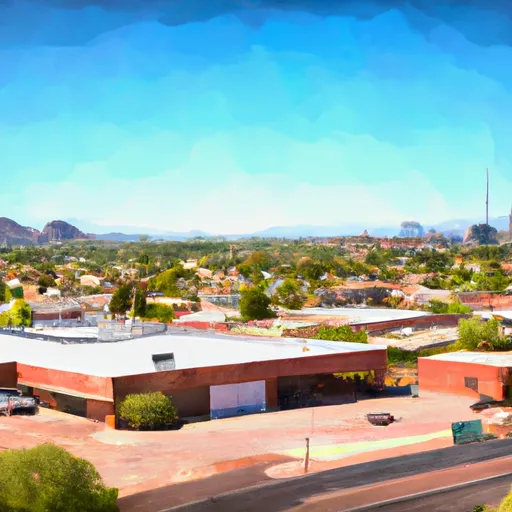-
 Snoflo Premium
Snoflo Premium
Get unlimited access to all our content
With no Ad interruptions! - Start Your Free Trial Login with existing account
Youngtown
Eden Index
Climate
7.5
•
Recreation
2.5
•
Community
2.2
•
Safeguard
4.4/10

Youngtown is a small town located in Maricopa County, Arizona, with a population of approximately 6,000 residents. Situated in the Sonoran Desert, Youngtown experiences a typical arid climate with hot summers and mild winters. Summers are characterized by scorching temperatures, often exceeding 100°F, while winters are mild, with daytime temperatures averaging around 60°F.
Hydrologically, Youngtown is not blessed with abundant water resources. The town receives a meager annual average rainfall of less than 10 inches, making water conservation and management crucial. The primary water source for Youngtown is the Central Arizona Project, which brings Colorado River water to the region.
Despite its arid surroundings, Youngtown offers several outdoor recreation opportunities. The nearby White Tank Mountain Regional Park is a popular destination for hiking, picnicking, and wildlife viewing. The park spans over 30,000 acres, featuring numerous trails that cater to various skill levels. Lake Pleasant Regional Park, located a short drive away, provides opportunities for boating, fishing, camping, and hiking. Additionally, the town has various parks and green spaces where residents and visitors can enjoy outdoor activities such as jogging, walking, and family picnics.
What is the Eden Index?
The Snoflo Eden Index serves as a comprehensive rating system for regions, evaluating their desirability through a holistic assessment of climate health, outdoor recreation opportunities, and natural disaster risk, acknowledging the profound impact of these factors on livability and well-being.
Climate Health Indicator (CHI): 7.5
Youngtown receives approximately
207mm of rain per year,
with humidity levels near 46%
and air temperatures averaging around
23°C.
Youngtown has a plant hardyness factor of
9, meaning
plants and agriculture in this region tend to thrive here all year round.
By considering the ideal temperature range, reliable water supplies, clean air, and stable seasonal rain or snowpacks, the Climate Health Indicator (CHI) underscores the significance of a healthy climate as the foundation for quality living.
A healthy climate is paramount for ensuring a high quality of life and livability in a region, fostering both physical well-being and environmental harmony. This can be characterized by ideal temperatures, reliable access to water supplies, clean air, and consistent seasonal rain or snowpacks.
Weather Forecast
Streamflow Conditions
Lower Gila-Agua Fria
Area Rivers
Lower Gila-Agua Fria
Snowpack Depths
Lower Gila-Agua Fria
Reservoir Storage Capacity
Lower Gila-Agua Fria
Groundwater Levels
Recreational Opportunity Index (ROI): 2.5
The Recreational Opportunity Index (ROI) recognizes the value of outdoor recreational options, such as parks, hiking trails, camping sites, and fishing spots, while acknowledging that climate plays a pivotal role in ensuring the comfort and consistency of these experiences.
Access to outdoor recreational opportunities, encompassing activities such as parks, hiking, camping, and fishing, is crucial for overall well-being, and the climate plays a pivotal role in enabling and enhancing these experiences, ensuring that individuals can engage in nature-based activities comfortably and consistently.
Camping Areas
| Campground | Campsites | Reservations | Toilets | Showers | Elevation |
|---|---|---|---|---|---|
| Estrella Mountain Regional Park | 7 | 913 ft | |||
| Lake Pleasant | 150 | 1,830 ft | |||
| White Tank Mountain | 40 | 1,428 ft |
Nearby Fishing
Catastrophe Safeguard Index (CSI):
The Catastrophe Safeguard Index (CSI) recognizes that natural disaster risk, encompassing floods, fires, hurricanes, and tornadoes, can drastically affect safety and the overall appeal of an area.
The level of natural disaster risk in a region significantly affects safety and the overall livability, with climate change amplifying these risks by potentially increasing the frequency and intensity of events like floods, fires, hurricanes, and tornadoes, thereby posing substantial challenges to community resilience and well-being.
Community Resilience Indicator (CRI): 2.2
The Community Resilience Indicator (CRI) recognizes that education, healthcare, and socioeconomics are crucial to the well-being of a region. The CRI acknowledges the profound impact of these elements on residents' overall quality of life. By evaluating educational resources, healthcare accessibility, and economic inclusivity, the index captures the essential aspects that contribute to a thriving community, fostering resident satisfaction, equity, and social cohesion.

